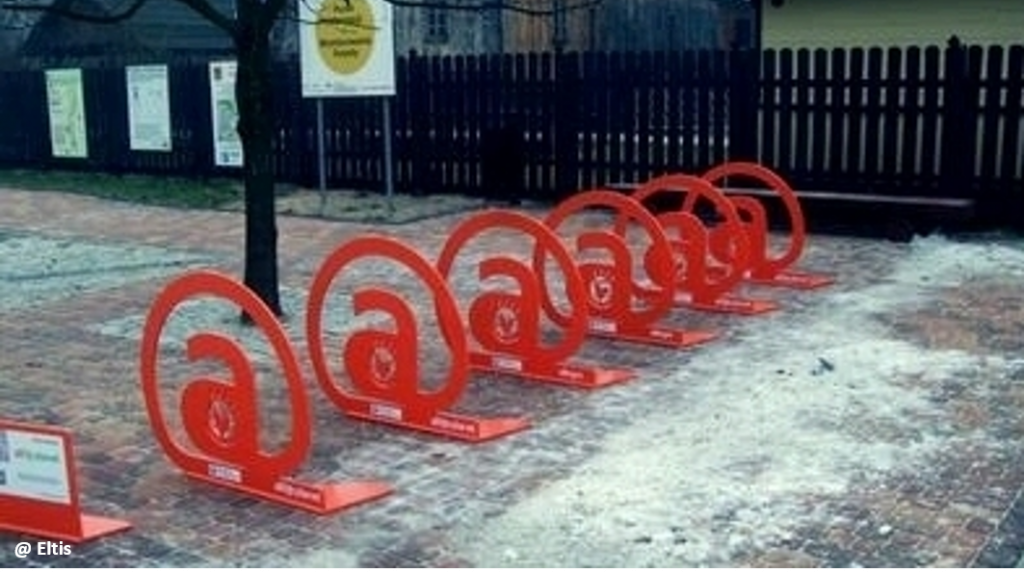
1. Presentation
Provision of safe bicycle parking in convenient locations for its users.
2. Objectives
- Ensuring cycling is convenient by enabling the bicycle to be parked close to the destination.
- Increasing the bicycle’s competitiveness as a door-to-door means of transport.
3. Measure’s importance
The importance of this measure relates to the need of ensuring a favourable environment for cycling by allowing it to be safely parked at destination and to overcome the fear of theft and vandalism (pointed as one of the main obstacles to using an own bike). In addition, it is essential to manage bicycle parking in public spaces, especially in the centre of cities, in order to avoid unorganized parking that degrades the quality of public space, invariably harming the pedestrian, and which may even discourage potential cyclists if it is difficult to find a suitable parking place.
Bicycle parking, together with lockers and surveillance systems, are a low-cost measure that provides storage options with protection from weather and theft.
1. Good Practices
– The requirements for bicycle parking can be summarized as: need for safety and protection and convenience, that is, the possibility of leaving the bicycle as close to the destination as possible.
– A bicycle parking policy should address: the different needs of users (short term parking and long term storage); the level of demand; the need for storage in residential zones.
– For rotary, short-term parking, proximity and facility/ quickness of parking are the priorities.
– For long-term storage, the level of safety and protection (sheltered or indoor parking) are the most important factors.
– Accounting for demand levels should estimate the required capacity and location of the parking lots.
– In the case of new urban developments, the minimum target values for parking and storage of bicycles (related to the potential modal share) should be met and included in territorial management regulations.
– In starter cycling cities, it is important that the competent authorities (at national, regional or local level) establish legally binding minimum requirements for bicycle parking.
– Monitor citizens’ adaptation to changes and reformulate measures to respond to users’ needs, without compromising sustainable ideals (See Management, monitoring
and maintenance).
– Explain the principles behind the measures taken so that their need and functioning are clear (See Information).
2. Actions
 | Short-term parking – inverted U-shaped stands (Sheffield type) They meet the best conditions of safety and versatility and recommended by the various manuals on the subject. The Bicycle Parking Manual of the Portuguese Cycling and Bicycle Users Federation (FPCUB) suggests the minimum distance between stands of 75 cm and preferably of 120 cm. Advantages: Stable and high compatibility. Easily integrated into public space. Robust and requiring low maintenance. |
 | Short-term parking – front-wheel grips Stands that only support the low front-wheel or just one point of the bike frame should be avoided, as they do not provide stability and safety and are may damage the bike. Disadvantages: Instability for the bicycle. Reduced functionality Low security. |
 | Sheltered Cycle parking It is recommended that the main bicycle parking lots are covered, either by locating them within a building or providing a suitable shelter (located near the entrance of the building/ amenity it serves). Advantages: Protection from the weather. Disadvantages: Additional investment and maintenance costs. |
 | Bicycle Lockers Advantages: Protection from theft, vandalism and inclement weather. Collective lockers for around 5 to 8 bicycles are sized to be installed on 1 car-parking space Disadvantages: More expensive solution. |
 | Supervised Storage For areas where large number of cyclists need to park for long-term. Advantages: Reduce risks of theft and vandalism. Bicycle maintenance and hire services can be provided. Disadvantages: Additional investment and maintenance costs. |
 | Unmanned Automated Storage Similarly to supervised parking facilities, there are examples of fully automated bicycle storage systems. Advantages: Saving on personnel costs. Disadvantages: Given absence of human presence, special attention needs to be taken to security in terms of visibility and lighting. Additional investment and maintenance costs. |
* Some European countries have defined the number of bicycle parking places according to land use:
| Housing | 1 spot for studios or 1-bedroom apartments; 4 spots for 4-bedroom apartments; etc. |
| Services | Employees: 2 spots/10 work stations
Visitors: 0,5 – 2 spots/ 10 work stations (variable depending on the flow of visitors) |
| Trade | Employees: 2 spot /10 work stations
Costumers: 0,5 – 3 spots/ gross area of trade built-up area |
| Industry | Employees: 2 spots/10 work stations
Visitors: 0,5 spots/10 work stations |
| Accommodation and food services | Employees: 2 spots/10 work stations
Costumers: 1-2 spots/ 10 work stations |
| Education facilities | Students (varies according to education level): 1 – 7 places /10 students
Teachers: 2 spots/10 teachers |
| Culture, leisure and sports facilities | Sports centre: 4 spots/10 locker-room spaces
Theatre: 1 spot/10 seats Cinema: 4 spots/10 seats |
| Public transport stops and stations | 1 – 4 spots / 10 commuters (departing from each stop/station) |
Source: IMTT, 2011.
1. Impacts
 | Mobility system efficiency Provision of bike parking can encourage an increase in the cycling modal share, contributing to a reduction in congestion and an increase in the efficiency of the mobility system. |
 | Livable streets Provision of bike parking duly developed helps to de-clutter public spaces and avoid conflicts with different users. |
 | Protection of the environment When car use is reduced as a result of the Provision of bike parking, there will also be a reduction in the levels of air and noise pollution will also decrease, including reduced CO2 emissions. |
 | Inclusion, equity and accessibility Some groups of people with lower incomes may benefit from the improved low cost mobility option that cycling provides. Provision of secure bike parking and storage is important to remove the concern for bicycle theft and to make it more accessible to all. |
 | Safety and comfort Provision of bike parking and storage directly enhances users’ safety and comfort. |
 | Economic value The provision of quality bike parking facilities in a local centre may encourage greater use of local shops and services. |
 | Awareness and acceptability One of cyclists’ concerns is where to leave the bicycle after the end of the trip and also concerns for theft. As such, providing safe bicycle parking will increase the confidence of cyclists and consequently encourage and normalize cycling. |
Legend:
| Very positive | Positive | Neutral | Negative | Very negative |
2. Barriers
 | Legal In most cases there are no obvious legal barriers to the provision of bike parking and storage. Where there are proposals to introduce cycle storage on parking spaces or the public roadway, the legal framework should be checked. |
 | Finance The options of bike parking and storage can vary significantly, but the simplest forms of short-term parking provide a relatively low cost intervention measure. |
 | Governance May involve public authorities, relevant transport providers and, potentially, businesses, cycling organizations and other interest groups. It is not expected that very complex arrangements would be necessary to implement a bike parking measure. |
 | Political acceptability Measures relating to cyclists and pedestrians often have less priority than measures relating to motorized vehicles. |
 | Public acceptability Support from a range of groups and pro-cycling lobbies is expected, but also opposition to significant investment in cycling, particularly if this is at the expense of other transport modes or other public services. |
 | Technical feasibility Apart from automated storage solutions, the technical requirements for bike parking and storage are not complex. |
Legend:
| No barrier | Minimum barrier | Moderate barrier | Significant barrier |
3. Budget
| Area | Measure | Unit | Cost | Implementation year |
| University of Porto, Porto Metropolitan Area (Portugal) | Bike racks Purchase | 265 stands | 66 558,00 € | 2018 |
| Maia, Porto Metropolitan Area (Portugal) | Bike racks Purchase | 21 stands | 6 216,00 € | 2018 |
| Matosinhos Porto Metropolitan Area (Portugal) | Purchase and installation of supports | 5 electronic lockers e 1 automated kiosk for cyclists’ support | 49 590,00 € | 2018 |
| Supply and assembly of parking | 100 units | 9 100,00 € | 2018 | |
| Loulé, Faro (Portugal) | Fire-fighting, rescue and safety equipment for the bike parking system | 1 year | 7 398,00 € | 2019 |
| LCD Replacement on bike stands of the VLM Public Bikes System | 12 780,00 € | 2019 | ||
| Lisbon, Lisbon Metropolitan Area (Portugal) | Supply and assembly of ‘Sheffield’ type stands, including floor casing | 850 stands | 51 890,00 € | 2018 |
| Áustria | Stand | 1 stand | 85,00 € | Data from 2013 |
| Bicycle space in covered and illuminated parking | 1 000,00 € | |||
| Hanging rack | 25,00€-75,00€ | |||
| Bike frame support | 100,00€-180,00€ | |||
| Mobile bike parking for events | 150,00€-175,00€ | |||
| Long-term sheltered parking | 600,00€-1000,00€ | |||
| Long-term sheltered and illuminated parking | 700,00€-1125,00€ | |||
| Bicycle stations | 3 000,00€-6 000,00€ | |||
| Long-term mobile bike parking | 450€-700€ | |||
| Bike boxes | 500,00€-2500,00€ | |||
| Bike boxes with charging station for e-bikes | 1 200,00€-5 000,00€ | |||
| Lockers | 300,00 € | |||
| U.K. | Bicycle stations shared with shops and services | 200m2 | 1,75 million £ | 2007 |
| 20 000m2 | 25 million £ | 2011 | ||
| Greater Manchester (U.K.) | Construction of bike parking | 15 stations; 1 206 parking spots; access by CCTV security card | 0,12 – 0,20 million £ (standard parking); 0,30 million £ (station conversion); 0,40 – 0,70 million £ (“cycling centres”*) | Data from 2017 |
| Cambridge, Cambridgeshire (U.K.) | Construction of bike parking | 2 850 spots, including hanging rack for normal bikes e space for large bikes; bicycle stair ramps; 24h free access; CCTV security; bike store and repair shop | 2,5 million £ (1,2 million £ for bike specific internal works)** | 2016 |
| Seville, Andalusia (Spain) | Bike parking racks | 155 areas with 712 spots | 162 000,00 € | 2007 |
Case Study 1: Bike parking at Stations in the Netherlands
Practically all stations in The Netherlands are equipped with parking and bicycle storage centres, including: Surveillance and covered system; Bicycle rental and accessories; Maintenance services; Lockers.
Learn more: www.eltis.org/discover/case-studies/how-dutch-railway-stations-encourage-multimodality
Impact:
 | Mobility system efficiency In The Netherlands, the combined use of cycling and public transport modes is a popular option, resulting in a significant reduction in road congestion. Bike parking forms an integral and important part of the cycling network. |
 | Livable streets Bike parking contributes towards a modal shift to cycling, which in turn can provide opportunities for social interaction and help to reduce noise and air pollution. It also reduces the potential for bicycles to clutter and block pavements. |
 | Protection of the environment In the Netherlands, the combined use of cycling and public transport modes is a popular option, resulting in a significant reduction in levels of noise and air pollution, including reduced CO2 emissions. |
 | Inclusion, equity and accessibility Use of bike parking and storage is not restricted and therefore all groups are able to benefit from cycling as a cheap and convenient travel mode. |
 | Safety and comfort The provision of bike parking increases the levels of users’ safety and comfort, protecting against theft and providing convenience in parking close to destination. |
 | Economic value The provision of quality bike parking in a local centre may encourage an increased use of local stores and services, although the case study does not present evidence confirming it. |
 | Awareness and acceptability No data. |
Case Study 2: Bike Parking planning through social media (Poland)


The action “Cycle for kilometres, park in an atmospheric/pleasant place” is a competition where participants record the distance travelled through an online application. This app also allows participants to identify places for new cycle parking lots and add cycling routes to a database. Based on this information, the foundation chose the most relevant locations and dealt with the formalities for installing the new cycle parking lots. By 2012, participants had already covered a total of 80000 kilometres, and more than 685 bicycle racks with 1170 places were installed in 77 locations in 7 major cities.
Learn more: www.eltis.org/discover/case-studies/cycle-kilometres-park-atmospheric-place-cycling-action-poland
Impact:
 | Mobility system efficiency There is no data available on whether the provision of bike parking achieved a modal shift towards cycling. However, the overall perception is that the campaign increased bicycle commuting levels. |
 | Livable streets Bike parking can contribute positively to the streetscape, as well as reducing the cluttering of a street that can arise from the random parking of bicycles. |
 | Protection of the environment There is no data available on whether the provision of bike parking achieved a modal shift towards cycling or mitigating effects on CO2 and other pollutants. However, the overall perception is that the campaign increased bicycle commuting levels, with positive effects on the environment. |
 | Inclusion, equity and accessibility The use of bike parking and storage is not restricted and therefore all groups are able to benefit from cycling as a cheap and convenient mode of transport. |
 | Safety and comfort The provision of bike parking increases the levels of users’ safety and comfort, protecting against theft and providing convenience in parking close to destination. |
 | Economic value The provision of quality bike parking in a local centre may encourage an increased use of local stores and services, although the case study does not present evidence confirming it. |
 | Awareness and acceptability No data. |
Legend:
| Very positive | Positive | Neutral | Negative | Very negative |
Ayuntamento de Sevilha (2007). Plan director para el fomento del transporte en bicicleta. Sevilla 2007-2010. Accessed 2 July 2019. Available at: www.sevilla.org/sevillaenbici/plandirector/planbicisevilla.html
ECF (2018). Making Buildings fit for Sustainable mobility. Accessed 17 July 2019. Available at: ecf.com/system/files/Bicycle%20vs%20Car%20Parking%20in%20Building%20Codes_ECF_ONLINE.pdf
Eltis. The urban mobility observatory (2014) Cycle for kilometres. park in an atmospheric place – cycling action in Poland. Accessed 1 July 2019. Available at: www.eltis.org/discover/case-studies/cycle-kilometres-park-atmospheric-place-cycling-action-poland
Ferrando, H., Anaya, E., González, D., & Sterbova, E. (2009). Manual de aparcamientos de bicicletas. Accessed 22 July 2019. Available at: www.uv.es/preven/mediambient/documents/Manual%20de%20aparcamientos%20de%20bicicletas%20del%20IDAE.pdf
FPCUB. Federação Portuguesa de Cicloturismo e Utilizadores de Bicicleta (2015). Manual de Estacionamentos para bicicletas. Accessed 1 July 2019. Available at: www.fpcub.pt/files/2011/08/Manual_estacionamento_fpcub_v2.pdf
IMTT (2011). Princípios de Planeamento e Desenho. Colecção de Brochuras Técnicas / Temáticas Rede Ciclável – Princípios de Planeamento e Desenho
KonSULT. Knowledgebase on Sustainable Urban Land use and Transport. (2014). Cycle and Parking & Storage. Accessed 1 July 2019. Available at: www.konsult.leeds.ac.uk/pg/20/
MUBI. Associação pela Mobilidade Urbana em Bicicleta (2014). Plano de Mobilidade Sustentável do Concelho da Maia – estacionamento para bicicletas. Accessed 1 July 2019. Available at: mubi.pt/2014/03/29/plano-de-mobilidade-sustentavel-do-concelho-da-maia-estacionamento-para-bicicletas/
OFROU – Office fédéral des routes (2008). Stationnement des vélos Recommandations pour la planification, la réalisation et l‘exploitation. Berne: OFROU. Accessed 17 July 2019. Available at: www.astra.admin.ch/dam/astra/fr/dokumente/langsamverkehr/lv_v07_veloparkierung-handbuch2008.pdf.download.pdf/md_g07_stationnementdesvelos-manuel2008.pdf
PRESTO. Promoting Cycling for Everyone as a Daily Transport Mode (2010). Cycling Policy Guide Infrastructure. Accessed 1 July 2019. Available at: ec.europa.eu/energy/intelligent/projects/sites/iee-projects/files/projects/documents/presto_policy_guide_cycling_infrastructure_en.pdf
Taylor, I. & Hiblin, B. (2017). Typical Costs of Cycling Interventions: Interim analysis of Cycle City Ambition schemes. Accessed 2 July 2019. Available at: www.transportforqualityoflife.com/policyresearch/cyclingandwalking/
